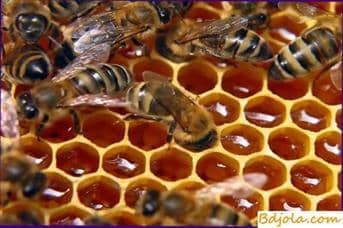
High concentration of sugars of honey ensures its long-term preservation. But bees have a method that reliably protects this product from spoilage during long-term storage: bees give the honey a sharply acid reaction (active acidity), and in acidic environments can not develop fungal spores, putrefactive and other bacteria.
Two days after feeding the bees to a pure sugar syrup having a neutral or slightly alkaline reaction (pH 7.5), the reaction of this syrup processed by bees turns out to be sharply acidic (pH 3.9). When carrying and processing bees a sugar solution, the content of acids in it increases.
Honey always contains organic and inorganic acids that make up nectar. However, the content of these acids is small, and they can not create such a high active acidity, which is characteristic of honey.
More recently, it was found that high active acidity occurs in ripening nectar as a result of the activity of bees. The composition of the pharyngeal gland secretions released enzyme Glyukogenaza acting on glucose, converting it to gluconic acid. In one experiment, the bees were fed with pure glucose.
The beef processed food contained gluconic acid and had a high active acidity. Other families were fed pure fructose; The food created by these bees did not contain acids and had a neutral reaction. These experiments indicate that the enzyme of bees acts on glucose, converting part of it into gluconic acid, providing high acidity of honey.
As a result of the reaction of formation of gluconic acid, hydrogen peroxide is released. The substance is poisonous to bees, and it is immediately neutralized by the Action of the enzyme catalase , which is found in the secretion of the thoracic gland, which has an outlet channel at the base of the tongue. As a result of the research, the role of catalase has become clear, which is always found in honey crab, filled with nectar.
The activity of the enzyme of glucogenase decreases with increasing active acidity of the medium. Therefore, the formation of gluconic acid ceases when the maturing nectar reaches a certain degree of acidity.
Giving honey an acidic reaction serves as an additional and very effective means of its preservation. Sugar in a slightly acid solution can remain unchanged for a long time, while sugar in an alkaline or neutral solution in air is fermented and destroyed. Acidic environment hinders the development of putrefactive bacteria and, consequently, promotes the preservation of honey.
The acid reaction of honey is also important in preventing some diseases of bees. In confirmation of this, we can cite the results of an experiment that fed sugar beet syrup with the addition of alkaline substances (pH 9) to one group of bees, and another – acidified syrup (pH 5-6). The acidified top dressing obviously suppressed the development of noca spores in the epithelial cells of the midgut, while with alkaline feeding the epithelial cells filled with spores and almost completely collapsed.
Пчеловодный ящик. Органы выделения пчел.
Feeding base of beekeeping